In art, triangles are considered to be a strong element of artistic composition. Ancient Greeks devised the “Golden Triangle” or “Golden Ratio” to define an aesthetically pleasing focal point for art and architecture. Triangles guide the viewer’s eye to the three separate points. Images placed at the peak of a triangle appear superior. If the triangle is reversed, an image at the bottom will appear inferior. The simple geometric shape of a triangle can represent stability and act as a powerful anchoring element.
These considerations have contributed to the use of triangles in the designs of flags of the modern world. This article shares background information on the international flags that feature triangles and the countries that fly them.
Antigua and Barbuda

The flag of Antigua and Barbuda symbolizes the African heritage of its people.
©nortongo/Shutterstock.com
Antigua and Barbuda is an island nation in the West Indies that the United Kingdom colonized. It achieved full independence in 1981. Its flag consists of a red field with an inverted triangle in the center, divided horizontally into three colors. These colors are black, blue, and white. In the top black section is a yellow rising sun. The colors and shapes of the flag are full of symbolic meaning. Black, yellow, blue, and white stand for the African heritage of the people or the soil. Blue stands for hope or for the sea, while white represents sand.
Bahamas
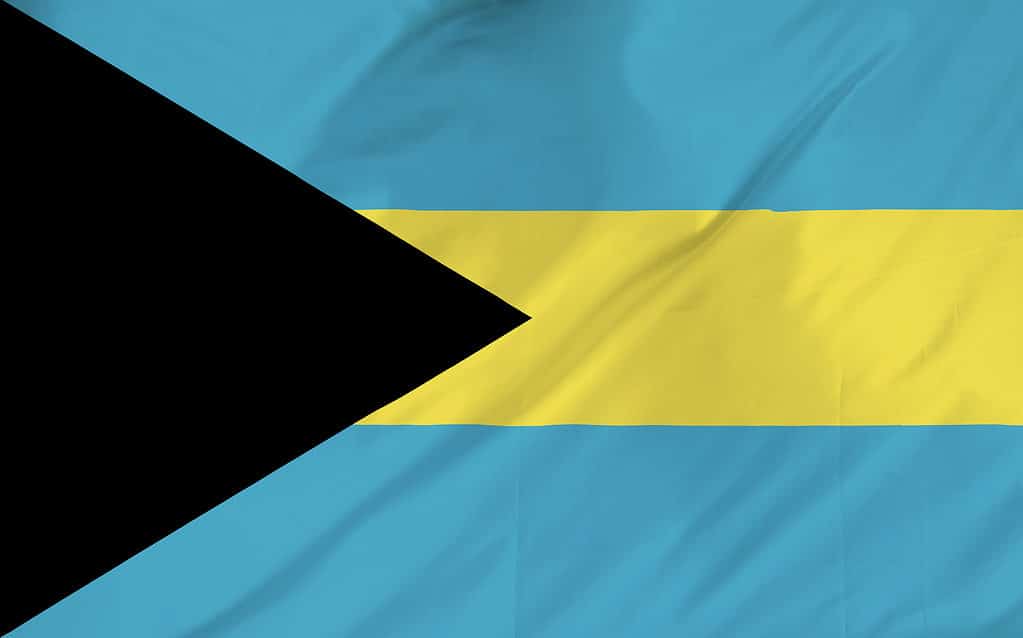
The flag of the Bahamas features the beautiful aqua shade of the Caribbean Sea.
©Sparrowbh/Shutterstock.com
The Bahamas is a sovereign nation in the Caribbean Sea that became independent from the United Kingdom in 1973. The flag has a triband with a golden central band bordered by aquamarine bands above and below. A black triangle is aligned to the hoist side. The gold represents the sun and the nation’s natural resources; aquamarine evokes the water of the sea around the islands. Black represents the strength and determination of the Bahamian people. Learn more about the flag of the Bahamas here.
Bosnia and Herzegovina

The Bosnia and Herzegovina flag features a yellow triangle.
©iStock.com/Oleksii Liskonih
Bosnia and Herzegovina is one of the countries that became independent in 1992 after the collapse of Yugoslavia. Its flag consists of an inverted yellow right triangle on a blue field, with seven full five-pointed white stars. Two half-stars sit at the top and bottom of the flag. The three points of the triangle represent the nation’s three main ethnicities: Bosniaks, Croats, and Serbs. The shape of the triangle represents the geographic shape of the country. The United Nations introduced the flag in the hopes that it would be a neutral and unifying symbol. A nation that has suffered through deep divisions was in great need of this.
Comoros
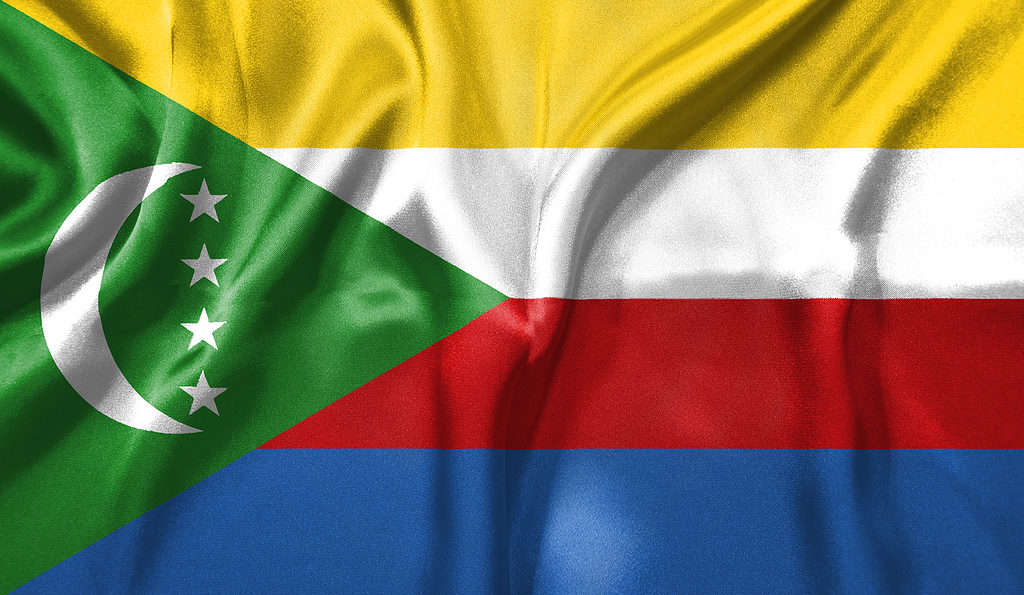
The green triangle on the Comoros flag represents Islam.
©iStock.com/Waehatman Waedarase
The Union of Comoros is a country consisting of three islands in the Indian Ocean located between Mozambique and Madagascar. This is the only Arab country entirely in the Southern Hemisphere. France colonized it and it achieved independence in 1975. Its flag includes four equal horizontal bands of yellow, white, red, and blue. A green isosceles triangle is located at the hoist side of the flag. Within the triangle is a white crescent and four white, five-pointed stars arranged in a vertical line. The four horizontal bands represent the four main islands of the Comoros archipelago. The green triangle represents Islam. The white crescent and stars represent the country’s position as a member of the Arab League.
Cuba
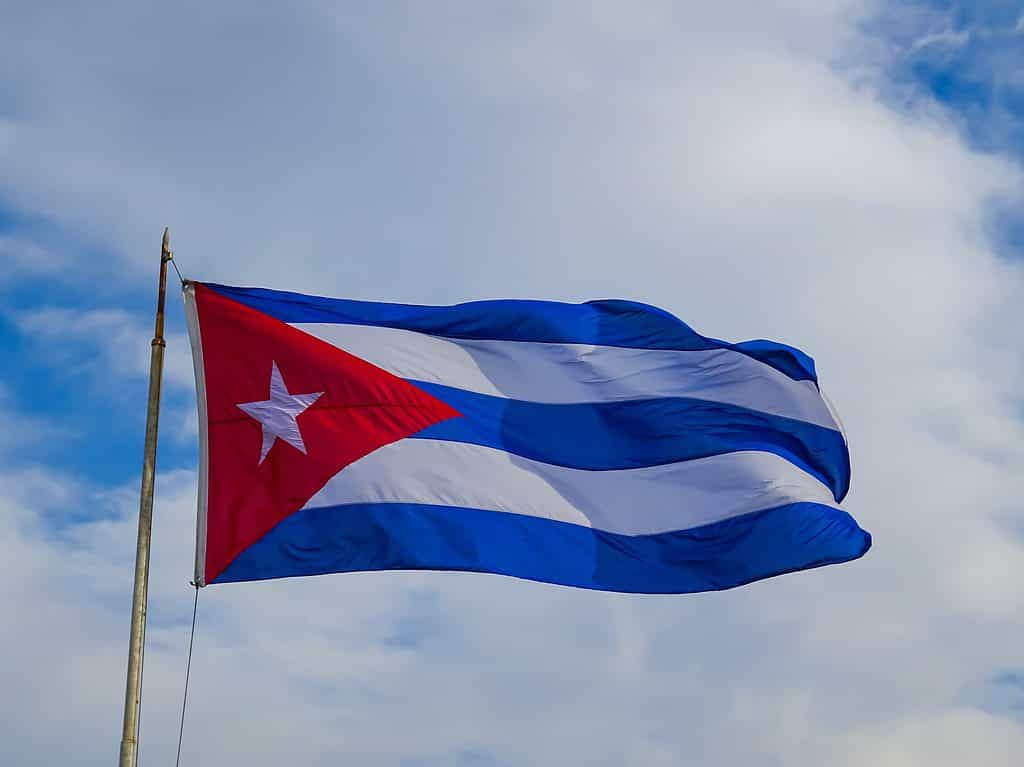
The Cuban flag represents their changing history.
©Giongi63/Shutterstock.com
The flag of Cuba consists of five equal horizontal bands alternating in color between blue and white. It has a red equilateral triangle at the hoist with a white five-pointed star in the center. After gaining independence from Spain in 1902, Cuba adopted a flag. This new flag was loosely inspired by that of the United States, located just 90 miles to the north. In the flag, the blue stripes represent the three departments of Cuba. White represents the purity of their cause, while the red triangle is a symbol of strength. The white star stands for the independence of the nation.
Czech Republic

The blue triangle was added to the Czech flag to distinguish it from the Polish flag.
©iStock.com/NatanaelGinting
The Czech Republic is a Central European country with a long and rich history. It’s been a battleground for centuries, switching hands between different European empires. It took its current form in 1993 when Czechoslovakia dissolved into the separate countries of the Czech Republic and Slovakia. The Czech flag is a simple tricolor design of red, white, and blue. It includes a hoist-side blue isosceles triangle and two broad horizontal bands of white and red. Because the flag was very similar to the Polish flag, they added a blue triangle to distinguish it. Red, white, and blue are common flag colors that signify revolutionary republican government over monarchial governments. These include the United States and France.
Djibouti
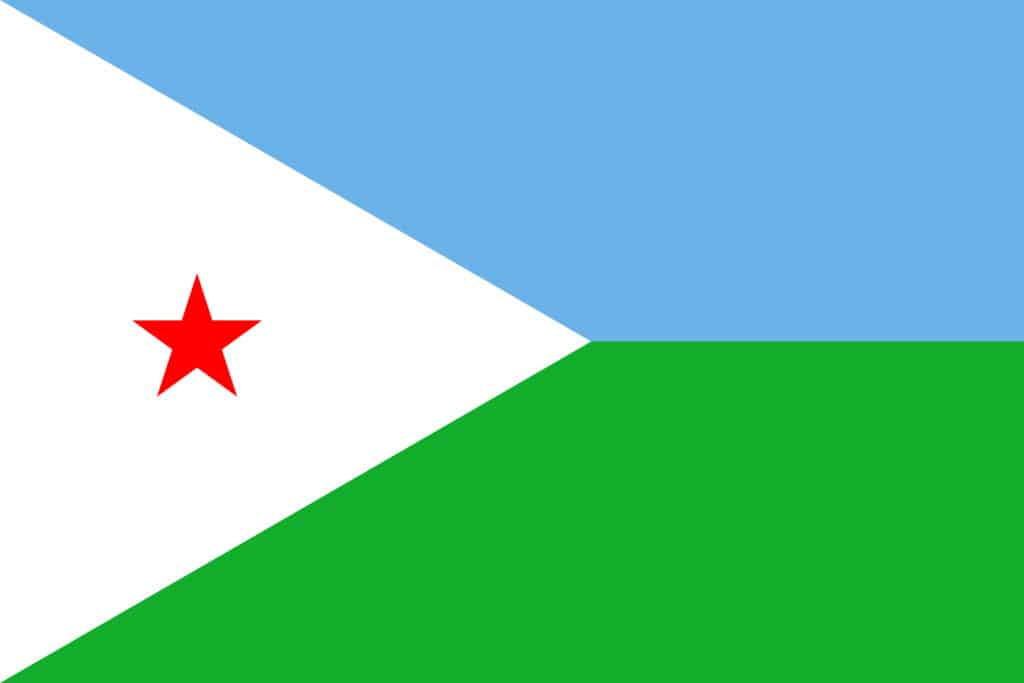
The flag of Djibouti contains white, blue, and green, with a red star.
©Atlaspix/Shutterstock.com
Djibouti is a small country in a strategically important location at the southern entrance to the Red Sea. It adopted its current flag upon winning independence from France in 1977. The flag has two equal horizontal bands of blue and green, with a white isosceles triangle on the hoist side. The blue band represents the sea and sky as well as the Somali people. The green band represents the land and the Afar people. The white triangle represents peace and unity. A red five-pointed star lies in the center of the triangle. It honors the blood of those who fought for independence.
East Timor
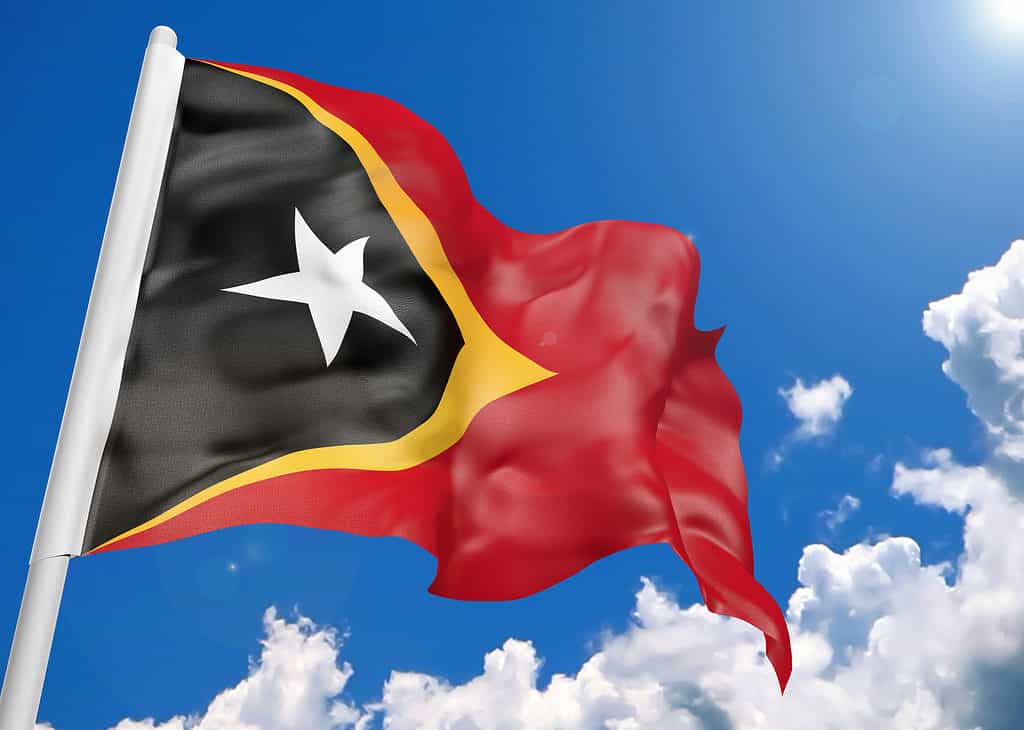
The flag of East Timor features a black triangle inside a larger yellow one.
©Digiart CT/Shutterstock.com
East Timor had a difficult road from a colony to a fully independent nation. Immediately after the country declared independence from Portugal in 1975, neighboring Indonesia invaded, and it remained under occupation for over two decades. After a UN-sponsored referendum in 1999, the country was finally fully independent in 2002. The flag of East Timor consists of a black isosceles triangle nested in a larger yellow one on a red field, with a white star in the center of the black triangle. The yellow color represents colonialism, black represents the deception to be overcome, red symbolises the struggle for independence, and white symbolises a guiding light of peace.
Equatorial Guinea

The blue triangle on the flag of Equatorial Guinea represents the sea and the country’s location.
©Dmytro Balkhovitin/Shutterstock.com
Equatorial Guinea, a country on the west coast of Africa, adopted its flag in 1968 upon independence from Spain. The flag of Equatorial Guinea consists of three horizontal bands of green, white, and red, with a blue triangle based on the hoist side. The green band represents the country’s natural resources, agriculture, and tropical jungles; the white band represents peace and purity, and the red band represents the blood of the country’s martyrs. The blue triangle represents the sea and the country’s location on the equator. Centered in the white band is the national coat of arms of the country.
Eritrea
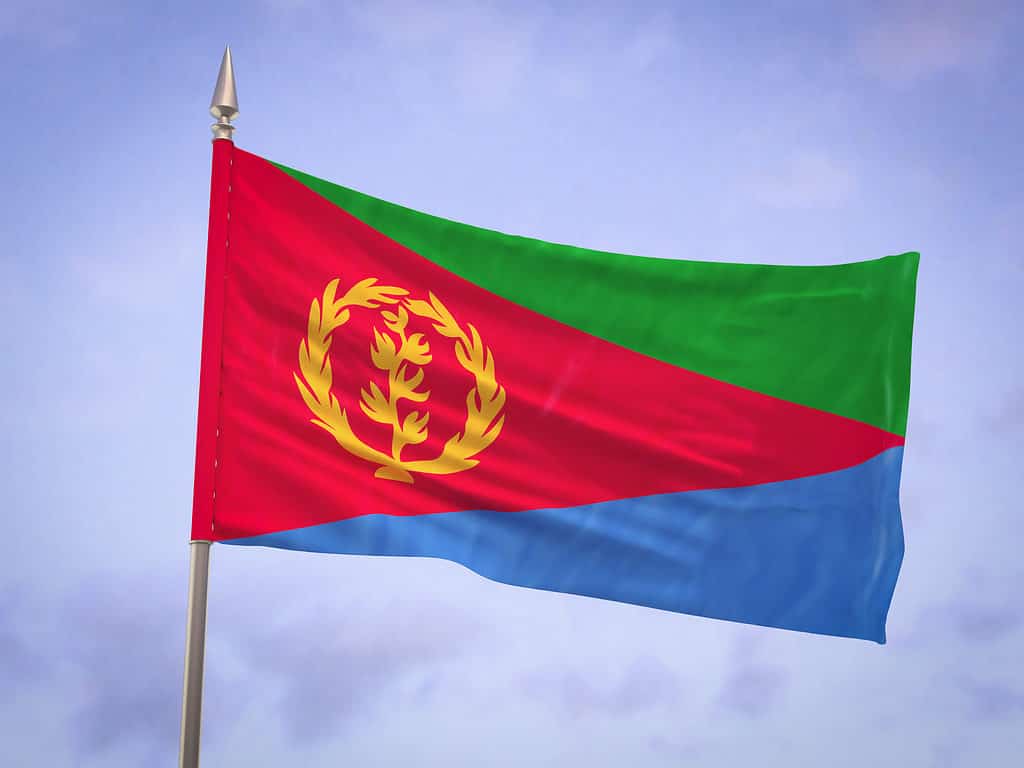
The flag of Eritrea features three triangles of different colors.
©iStock.com/Sven Loeffler
Eritrea is an African nation that lived under Italian and British colonial rule, then was an autonomous region of neighboring Ethiopia from 1952-1993. Upon independence, it adopted a flag divided entirely into three triangular shapes: a red isosceles triangle based on the hoist-side with a green right triangle above and a blue one below. In the red triangle is a golden emblem of a vertical olive branch encircled by an olive wreath. Red stands for the blood of the country’s freedom fighters; green is for the agriculture of the country; and blue represents the sea — namely, the Red Sea, where Eritrea has a long coastline.
Guyana

The flag of Guyana is known as the “Golden Arrowhead”.
©iStock.com/sezer ozger
Guyana, a former British colony on the north coast of South America, adopted its flag upon independence in 1966. The flag of Guyana is a green field with a black-bordered red isosceles triangle inside a larger white-edged golden triangle, both based on the hoist side. It is sometimes called the “Golden Arrowhead.” Red represents zeal and dynamism; gold represents mineral wealth; green stands for agriculture and forests, black for endurance, and white for the country’s abundant rivers and water resources.
Jamaica
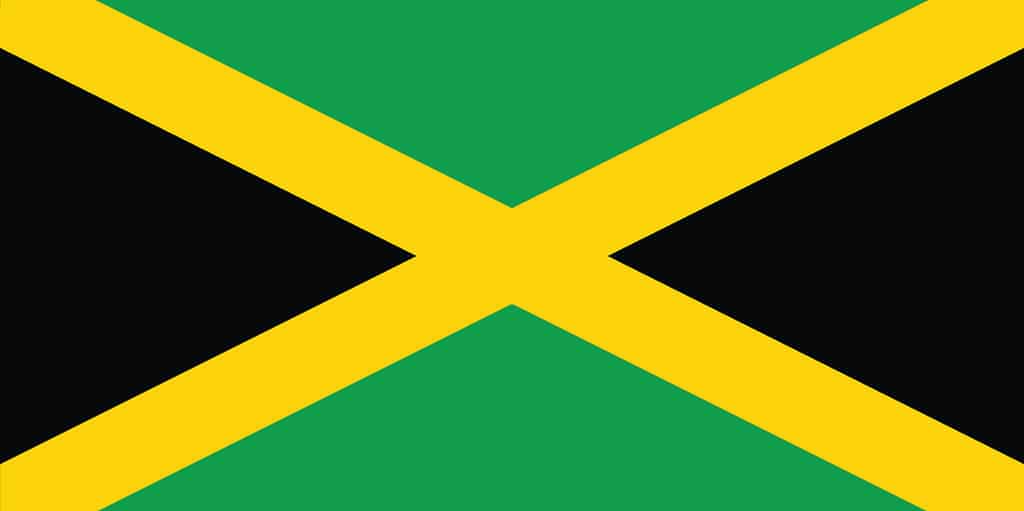
The Jamaican flag features a cross that divides the flag into four triangles.
©iStock.com/kckate16
The flag of Jamaica, a Caribbean island nation, is unique in all the world as the only national flag that does not use the colors red, white, or blue. It was officially adopted in 1962 when Jamaica became independent from British rule. The flag consists of a yellow cross, which divides the flag into four triangles: black ones based on the hoist and fly sides and green ones on the top and bottom. Black honors the strength and creativity of the population; gold for the natural wealth and sunshine of the country; and green for the tropical vegetation of the country, and its hope.
Jordan

The flag of Jordan has a horizontal triband of green, white, and black, with a red chevron at the hoist side and a white seven-pointed star.
©iStock.com/Burak Ceyhan
The flag of Jordan consists of three equal horizontal bands of black, white, and green. A red triangle is located at the hoist side of the flag, and within the triangle is a white star with seven points. Each of these colors is popular in Arab nations and represents different Islamic dynastic empires. The Red triangle represents the currently ruling Hashemite dynasty of Jordan as well as the Arab Revolt against the Ottoman empire in the early 20th century. Jordan adopted its flag after gaining independence from Ottoman rule in 1928. Although Jordan is geographically and numerically small compared to some of its neighbors, the colors of its flag show its part in centuries of Arab history and cultural achievements.
Mozambique
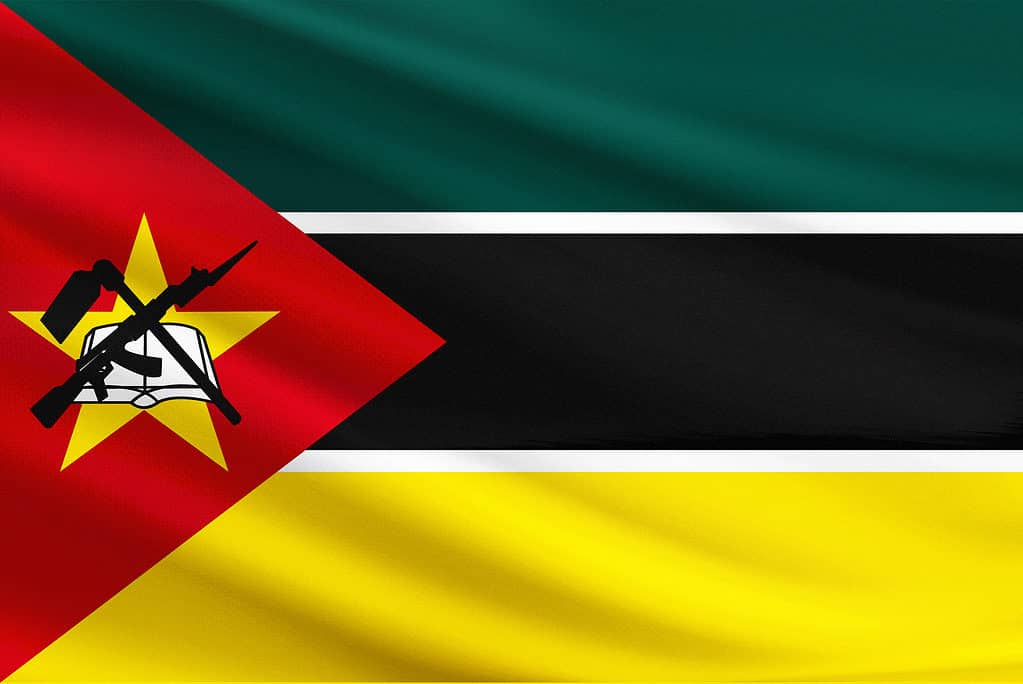
The flag of Mozambique features the colors of red, black, white, yellow, and green.
©Osman Bugra Nuvasil/Shutterstock.com
Mozambique, a southeast African coastal nation, gained independence in 1975, like many other Portuguese colonies. Its current flag was adopted in 1983. It features a red triangle based on the hoist side that represents the country’s independence struggle. Inside the triangle is a yellow five-pointed star with a superimposed open book and a crossed rifle and hoe. This powerful symbol stands for national priorities of defense, education, agriculture, and a spirit of solidarity. This is only one of four national flags in the world to include an image of a firearm; the others are Bolivia, Guatemala, and Haiti. The other three major colors of the flag, seen in horizontal bands are as follows: teal (rich land), white (peace), black (Africa), and yellow (mineral wealth).
Philippines

The flag of the Philippines is red and blue with small yellow stars on a white triangle.
©Osman Bugra Nuvasil/Shutterstock.com
The flag of the Philippines consists of a horizontal blue stripe at the top and a horizontal red stripe at the bottom, with a white triangle located at the hoist side of the flag. Within the white triangle is a golden sun with eight rays, representing the eight provinces that declared themselves as a united front against Spanish colonial rule in 1896. The three stars at the three corners of the triangle represent the three main regions of the Philippines: Luzon, Visayas, and Mindanao.
A clever feature of the flag’s design is that during times of war, it is flown upside down with the red field on top. A Spanish colony for 300 years, the Philippines gained independence from Spain with the help of the United States in 1898 and chose the colors red, white, and blue, reminiscent of the US flag. The Philippines achieved full independence from American administration in 1946.
Puerto Rico

The triangle on the flag represents the three branches of government.
©Artgraphixel/Shutterstock.com
Along with the Philippines and Guam, Puerto Rico was liberated from Spanish colonial rule with the help of the United States in 1898. Today it is not a fully independent country but is governed as a semi-autonomous commonwealth by the United States. Nonetheless, it has many features of a sovereign country, including its own flag. The Puerto Rican flag draws inspiration from both the Cuban and United States flags. It is basically the same design as the Cuban flag, with a blue triangle on the hoist rather than a red one, and alternating red and white stripes rather than blue and white as in the Cuban flag. Both flags have one white star in the center of the triangle. To Puerto Ricans, the red stripes represent the blood of brave warriors; white represents victory and peace; blue represents the sky and sea of this island country.
São Tomé and Príncipe
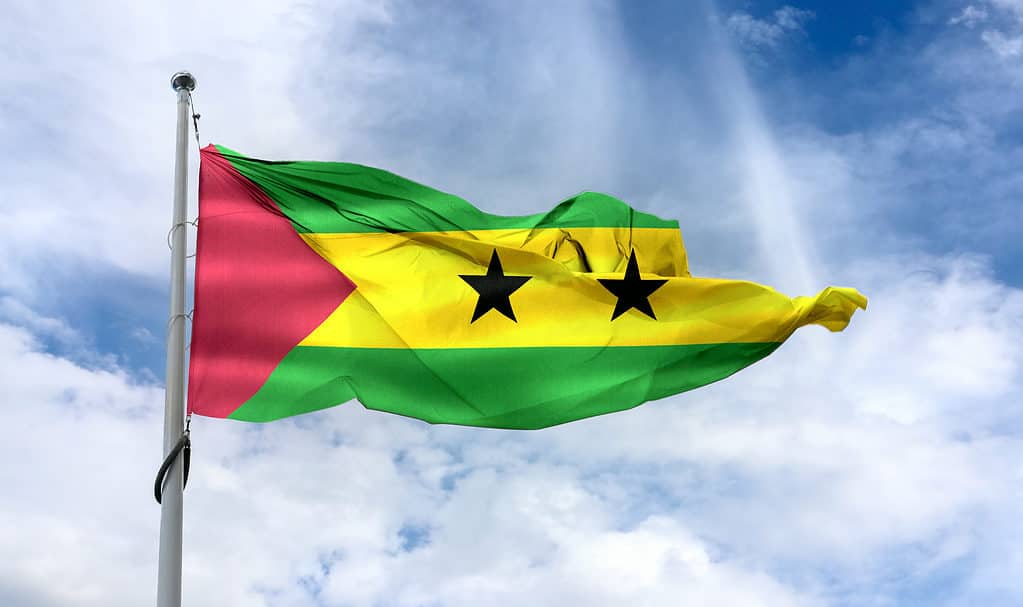
The flag of São Tomé and Príncipe was adopted when the country gained independence from Portugal in 1975.
©iStock.com/Wirestock
The flag of São Tomé and Príncipe, an island nation off the Atlantic coast of Africa, consists of three horizontal bands of green, yellow, and green, with two black five-pointed stars in the yellow band. It also has a red triangle based on the hoist side. Adopted when the country achieved independence from Portugal in 1975, the flag carries important symbolism. Green and yellow allude to the natural environment: vegetation, the tropical sun, and the key crop of cocoa. The two stars stand for the two islands that make up the country. The red triangle has a political meaning: the struggle for independence and equality.
Sint Maarten
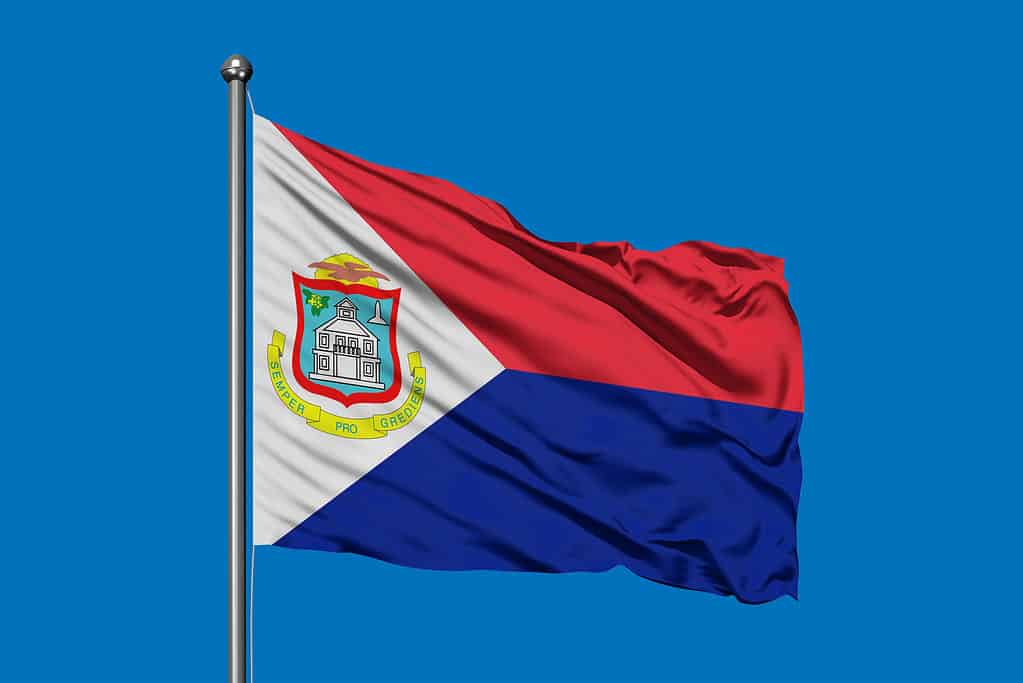
The flag of Sint Maarten features the country’s coat of arms on a white triangle.
©iStock.com/sezer ozger
Sint Maarten is a Caribbean nation that a Dutch colony originally established. It makes up the southern part of an island shared with the former French colony of Saint Martin to the north. Its flag consists of a white triangle on the hoist side with the rest of the flag covered by two broad horizontal bands of red and blue. The country’s coat of arms is in the center of the triangle. The blue represents the beautiful sky and sea of the island. Red honors the blood of the country’s citizens. The seal includes features representing agricultural abundance, human energy, the Dutch monarchy, the official flower, an important monument, a pelican in front of a yellow sun, and a Latin inscription meaning “always progressing.
Saint Lucia

The flag of Saint Lucia has one of the most unusual designs with three triangles that represent the Pitons.
©nortongo/Shutterstock.com
Saint Lucia boasts one of the most futuristic-looking flags on the planet. Most of the flag is a field of light blue representing the clear skies and seas of the Caribbean. The center of the flag includes three nesting triangles of white, black, and yellow. The triangular shapes represent the Pitons, which are two famous volcanic cones on the island that are national symbols. The black and white colors evoke peaceful relations between black and white people. Yellow symbolizes sunshine and prosperity. When the country became independent of the United Kingdom in 1979, they adopted the latest version of the flag.
South Sudan

The flag of South Sudan features a blue triangle on the left side of the flag with a yellow star in the middle of the triangle.
©iStock.com/bndart
South Sudan is a central African country that became independent from Sudan in 2011 after many years of struggle. The South Sudanese flag has three wide vertical bands of black, red, and green separated by white borders. A blue isosceles triangle on the hoist side with a golden star in the center completes the design. The color scheme represents the people of South Sudan (black); the blood spilled for freedom (red); agriculture, wealth, and progress (green); peace (white); the Nile River (blue); unity, hope, and determination (yellow). Many of these colors are popular in African flags, showing that Sudan relates to its neighbors.
South Africa
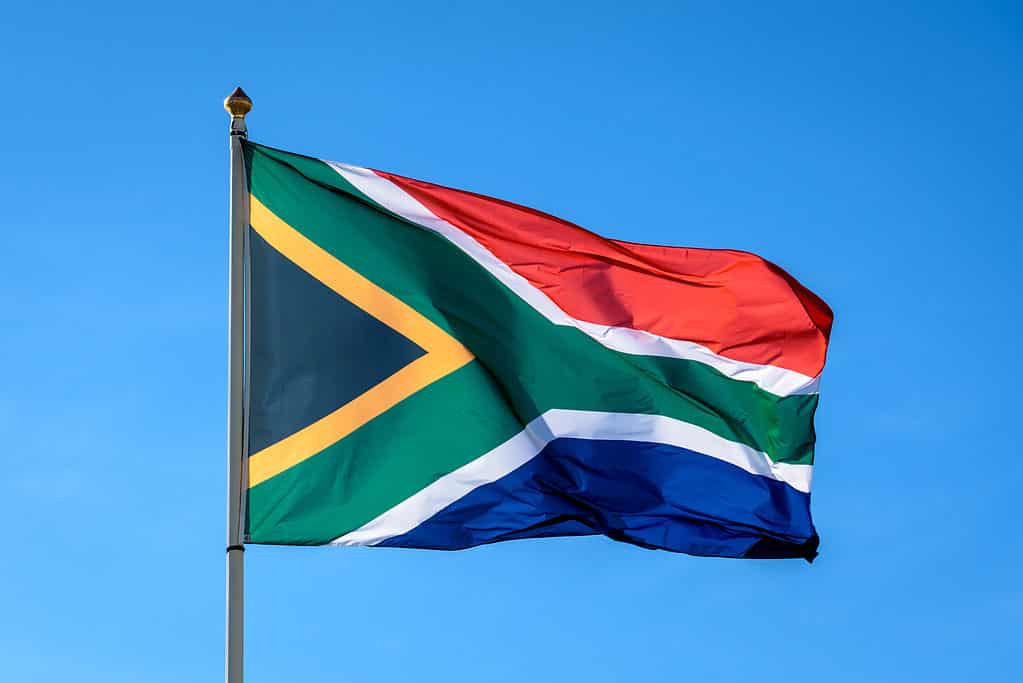
Surprisingly, the South African government states that no symbolism should be attached to the flag’s colors.
©iStock.com/olrat
The flag of South Africa was adopted in 1994 to replace one that had been used since 1928 under the apartheid government. Interestingly, while many countries assign deep meaning to the colors of their flags, the South African government says the colors do not symbolize anything. Instead, it is a synthesis of elements of the many flags the country has had during its history. One symbolic element is a central “Y” shape that stands for diverse elements of society, moving forward in unity. This shape divides the flag into three parts: a black hoist-side triangle and red and blue fields at the top and bottom right. Narrow yellow and white stripes outline the Y shape. By leaving the symbolism of the flag undefined, South Africa hopes its flag will be a unifying banner for all South Africans.
Vanuatu
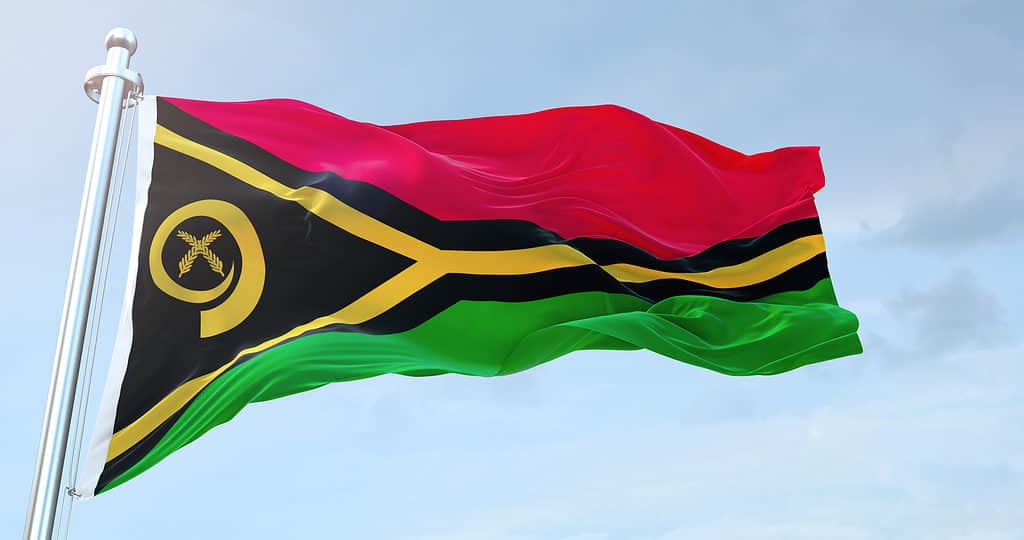
The main colors of the flag of Vanuatu are red, green, black, and gold.
©iStock.com/EA
A nation of islands in the southwest Pacific, Vanuatu was jointly administered by Great Britain and France until its independence in 1980. The country’s flag includes a black triangle based on the hoist side, outlined in gold and black, with gold and black bands continuing across the center of the flag. Red and green fields are at the top and bottom of the flag.
The main colors of the flag are red (the blood uniting all humanity), green (the wealth of the islands), black (the ni-Vanuatu people), and gold (in a Y-shape representing the shape of the archipelago and the light of the Christian gospel. In the center of the triangle is a golden boar’s horn surrounding two leaves of the local namele tree. Collectively, the symbol represents the country’s cultural heritage, prosperity, and peace and is often worn as a pendant on the islands as a constant reminder of the country’s values.
Zimbabwe

The national flag of the Republic of
Zimbabwe
features a white triangle that represents peace.
©Steve Allen/Shutterstock.com
The southern African nation of Zimbabwe gained independence from the United Kingdom in 1980. Its flag consists of seven equal horizontal bands in this order from top to bottom: green, yellow, red, black, red, yellow, and green. These are popular colors on many African flags. In Zimbabwe, they represent its green fields; its gold and other mineral wealth; the blood that was shed in the fight for freedom; and the race and culture of the African people. The flag also has a white triangle based on the hoist side, standing for peace. Within the triangle is a red, five-pointed star that is superimposed with a golden image of the Zimbabwe Bird — an artifact found at the archaeological site of the historical kingdom of Great Zimbabwe. This combined symbol looks to the nation’s great past, as well as the revolutionary struggle for freedom.
There you have it. Triangles have great symbolic meaning in the flags of many countries. Which is your favorite flag? If you’d like to see other designs, check out the links below.
The photo featured at the top of this post is © nortongo/Shutterstock.com
Sources
- ehow.com, Available here: https://www.ehow.com/info_10046244_definition-triangular-composition-art.html
- World Flags Portal, Available here: https://worldflagsportal.com/flags-with-triangles.html
- Wikipedia.org, Available here: https://en.wikipedia.org/wiki/Antigua_and_Barbuda
- Britannica.com, Available here: https://www.britannica.com/place/Vanuatu/History
- Siyabona Africa, Available here: https://www.mozambique.co.za/About_Mozambique-travel/mozambique-facts.html#:~:text=History%20of%20Mozambique,all%2C%20with%20the%20Arab%20world.
Thank you for reading! Have some feedback for us? Contact the AZ Animals editorial team.







